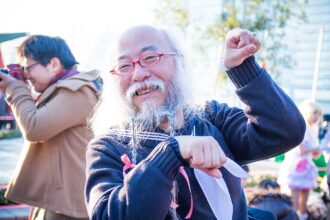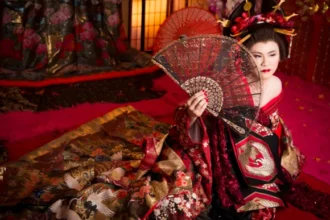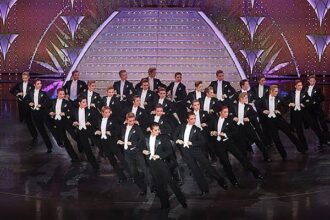What is Kabuki?
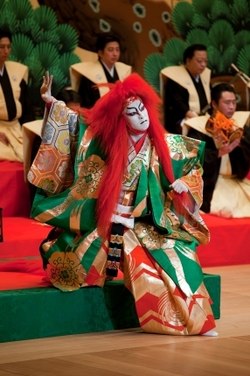
source: https://en.wikipedia.org/wiki/Renjishi
What Is The Definition of Kabuki?
Kabuki (歌舞伎) is a traditional theater form played by all-men troupes. It mixes music, dance, and acting. The acting is particularly exaggerated, and includes plays with the audience, almost like a pantomime. The extravagant costumes and makeup are all archetypes to signify a specific character (learn more about them later in this article). Two musical ensembles are used in kabuki, one onstage and one offstage.
Its repertory is derived from noh, similar to that of the classic puppet theater known as bunraku. However, unlike noh, the stories are made easy and entertaining for the audience, the movements are quicker and more exaggerated, and there is makeup instead of masks. Stories are based on legends (especially from the shinto religion), the seasons, and current events. Usually, it also conveys values and morals.
In modern Japanese, the word is written with three characters: ka meaning “song”, bu meaning “dance”, and ki meaning “skill.”
The History of Kabuki
The beginnings of kabuki date back to 1603, when a woman called Izumo no Okuni performed mocking and lascivious dances in front of patrons at a teahouse, dressed in flashy men’s garb and carrying a sword, playing a character called Kabukimono. So, yes, kabuki was started by a woman! Okuni quickly became popular and many women started to imitate her by wearing men’s clothing and dancing exaggeratedly, and thus, an art form was born.
Later, as the art form grew in popularity, the government banned women from performing it in1629, deeming it too amoral. Indeed, many women who were performing it were prostitutes. Women roles were then taken on by teenage boys, but that was also repressed in 1652 due to prostitution of those too (wakashudo). It was all adult men performing from then on. At that time, kabuki was often performed for comic relief between acts of noh performances.
Eventually, kabuki reached its peak towards the beginning of the 18th century. When so many art forms like noh were reserved to the noble and wealthy, kabuki was the art of the people. It brought great relief to artisans, farmers, or merchants who sometimes spent months at sea. Kabuki was shown from morning to evening, so everyone could find time to attend, and meals were a great communal time.
Overtime, the popularity of kabuki dwindled, especially following the arrival of Westerners to Japan. Today, it is still an revered art form, whose tradition still exists strongly, and it is customary to see it at least once in one’s life.
Super Kabuki
Super kabuki is a modernized form of kabuki, established in 1986 by Ichikawa En’ō II. It features traditional stories but with modern language and more stage effects, borrowing from Western stage plays and musicals, as well as circus arts.
What Are The Roles in Kabuki?
Male roles
Tachiyaku
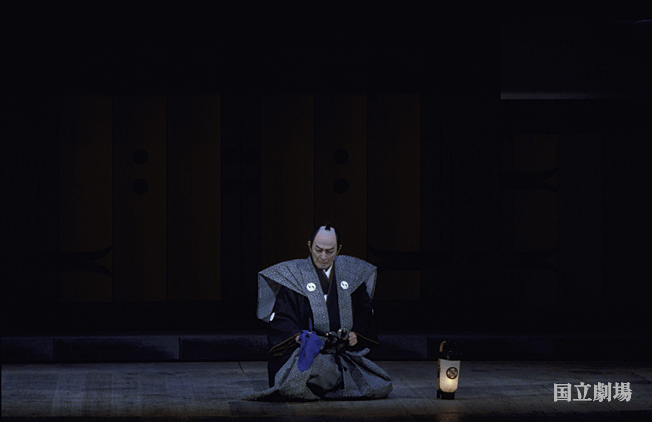
source: https://www2.ntj.jac.go.jp/dglib/modules/kabuki_dic_en/entry.php?entryid=1197
The tachiyaku is the good role, who is often the main character and the head of the troupe. He can be an exaggeratedly strong and successful hero (aragoto), or a softer romantic man (wagoto), or a more serious character with great leadership qualities (jitsugoto).
Katakiyaku
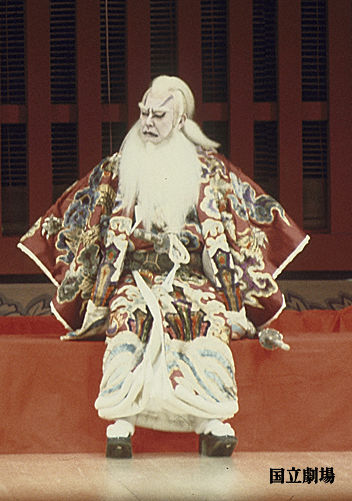
source: https://www2.ntj.jac.go.jp/dglib/modules/kabuki_dic_en/entry.php?entryid=1069
The katakiyaku is the villain that the tachiyaku has to metaphorically or literally fight. He can take on different forms: the malevolent aristocrat (kugeaku), the political opposant who wants to take Japan (kunikuzushi), the tachiyaku’s evil equal (jitsuaku), a handsome and cruel man (iroaku), or a funny and loveable criminal with a red face (akattsura).
Oyajigata
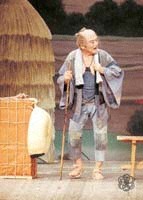
source: https://www2.ntj.jac.go.jp/dglib/contents/learn/edc25/en/evolution/stock-characters.html
He is an older man who usually delivers wisdom that helps the main character in their quest.
Wakashugata
source: https://www2.ntj.jac.go.jp/dglib/contents/learn/edc25/en/evolution/stock-characters.html
He is a handsome teenager there to make the scene more colorful.
Dokegata
source: https://www2.ntj.jac.go.jp/dglib/contents/learn/edc25/en/evolution/stock-characters.html
He is the comic relief character. There is also an evil version of him (handogataki).
Female roles
Onnagata
source: https://ja.wikipedia.org/wiki/%E7%A7%8B%E6%88%BF%E6%84%9A%E6%A8%82
Onnagata is the generic word for female roles played by men in kabuki. As kabuki is an all-men theater form, there are bound to be a lot of onnagata.
Musumeyaku
source: https://www2.ntj.jac.go.jp/dglib/contents/learn/edc25/en/evolution/stock-characters.html
She is a beautiful young woman, often in love. She can be a city girl (machi-musume), a countryside girl (inaka-musume), or a naive princess (akahime).
Nyoboyaku
source: https://www2.ntj.jac.go.jp/dglib/contents/learn/edc25/en/evolution/stock-characters.html
She is a middle-aged woman. She can be a loyal servant to a samurai family (kata-hazushi) or a selfless and virtuous woman (sewa-nyobo).
Keisei
source: https://www2.ntj.jac.go.jp/dglib/contents/learn/edc25/en/evolution/stock-characters.html
She is a beautiful, smart, and noble courtesan.
Akuba
source: https://www2.ntj.jac.go.jp/dglib/contents/learn/edc25/en/evolution/stock-characters.html
She is an evil middle-age woman who commits evil acts for a specific reason. She may act shy in front of her lover.
Fukeoyama
source: https://www2.ntj.jac.go.jp/dglib/contents/learn/edc25/en/evolution/stock-characters.html
She is an older woman with some importance in the story.
Onnabudo
source: https://www2.ntj.jac.go.jp/dglib/contents/learn/edc25/en/evolution/stock-characters.html
She is a skilled warrior who has to overcome challenges.
Notable Actors in Kabuki
Ichikawa En’ō II
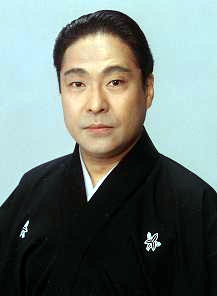
source: https://en.wikipedia.org/wiki/Ichikawa_En%27%C5%8D_II
Ichikawa En’ō II was an extremely popular kabuki actor, living from 1939 to 2023. He played a variety of female roles as well as animal / non-human roles, and some male roles. He was one of the few onnagata to be head of the troupe. He revolutionized the kabuki scene by adding more tricks (karen) such as flying over the crowd held by wires. He also invented Super Kabuki. His philosophy of acting was “Supîdo (‘Speed’), Sutôri (‘Story’) and Supekutakuru (‘Spectacle’)”.
Bando Tamasaburo V

source: https://en.wikipedia.org/wiki/Band%C5%8D_Tamasabur%C5%8D_V
Bando Tamasaburo V is known as the most famous current onnagata. He is particularly skilled in dance pieces, a part of kabuki that not everyone can do. He has also appeared in a variety of foreign stage plays, such as Chinese kunqu theater or the Bejart ballet, which led him to dancing with the uber-famous Jorge Donn.
Mitsugoro Bando X
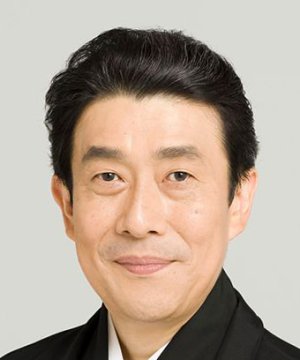
source: https://mydramalist.com/people/9330-bando-mitsugoro
Mitsugoro Bando X was born in 1956 and passed away in 2015. He was part of a long lineage of kabuki actors. He was married to a Takarazuka Review actress, Kotobuki Hizuru. He was also a television presenter and actor, acting in the famous 1985 film “Mishima: A Life in Four Chapters” as bonze Mizoguchi.
Ichikawa Danjūrō XIII

source: https://en.wikipedia.org/wiki/Ichikawa_Danj%C5%ABr%C5%8D_XIII
Ichikawa Danjūrō XIII, born in 1977, is a famous current kabuki actor and stage producer, specializing in tachiyaku, especially aragoto. He was previously known as Ichikawa Ebizô XI and Ichikawa Shinnosuke VII until the passing of his father in 2019 when he took on his name. Aside from kabuki, he is also a film and television actor.
Ichikawa Somegorō VIII
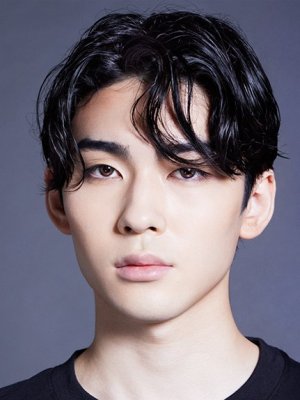
source: https://mydramalist.com/people/123571-ichikawa-somegoro-viii
Ichikawa Somegorō VIII, born in 2005, is one of the most popular young kabuki actors of our times. He is appreciated for his soft look. He started appearing on stage at just two years old. He is also a model and actor, a Shu Uemura ambassador, and he has walked for Versace as well.
Where To See Kabuki in Japan?
Kabukiza Theatre
Located in Ginza, Tokyo, this theater is probably the most famous in Japan, and was opened in 1889. The program changes every month. Kabuki-related goods can be bought in the same building.
Tickets can be bought on their official website (https://www.kabukiweb.net/theatres/kabukiza/) and range from 4,000yen to 20,000yen.
Shinbashi Enbu Theatre
This modern theater, located in an assuming building in Ginza, was established in 1925. It showcases traditional kabuki as well as Super Kabuki and even Shakespearian plays.
Tickets can be bought on their official website (https://www.kabukiweb.net/theatres/shinbashi/) and range from 3,000yen to 16,000yen.
National Theatre
Located in Hayabusachō, Tokyo, this theater has been operating since 1966. Note that it has been temporarily closed since 2023 due to renovations.
Tickets can be bought on their official website (https://ticket.ntj.jac.go.jp/top_e.htm?_bdsid=EWLZI.phbLnkG.1736437495082.1736437567&_bd_prev_page=https%3A%2F%2Fwww.ntj.jac.go.jp%2Fen%2Ftheatre%2Fnational_theatre%2F&_bdrpf=0) and range from 4,000yen to 20,000yen, with student prices available as well from 2,800yen.
Minamiza Theatre
The oldest kabuki theater in Japan, established in 1603, is located in Kyoto. The end-of-year lucky face performance is especially popular and has been an enduring tradition.
Tickets can be bought on their official website (https://www.kabukiweb.net/theatres/minamiza/) and range from 4,000yen to 13,000yen.
Shochikuza
This theater located in Dotonbori, Osaka was established in 1923 (it just celebrated its 100th anniversary!). It historically showed movies, and survived the air raids in 1945. Nowadays, a range of performances are played there, including kabuki and super kabuki.
Tickets can be bought on their official website (https://www.kabukiweb.net/theatres/shochikuza/) and range from 5,000yen to 22,000yen.
Where to See Kabuki Outside of Japan?
There are no specific venues that exclusively play kabuki outside of Japan. However, kabuki troupes sometimes tour the world, although that is a pretty rare phenomenon. In Australia, there is a kabuki troupe called the Australian National University Za Kabuki Club that has been performing since 1976. Some Western playwrights have been using tropes from kabuki into their play for some time. And of course, kabuki plays can be watched online.
How Does Kabuki Link To LGBTQ+?
Connection to LGBTQ+
Kabuki actors who portray women are sometimes considered even better-looking than real women, because some roles must portray desire and perfection. Kabuki is part of the long tradition of cross-dressing in Japan, which is deeply linked to modern LGBTQ+ culture through the drag and ball scene.
Find out more about crossdressing in Japan with our article!
Japanese Potential for the Acceptance of Gender Diversity
Japanese culture was always flexible in its understanding of sexual diversity. With such a long-standing art form where men play women, there is potential for better acceptance of LGBTQ+, especially transgender people, as more and more people come out today, through kabuki. At least, the concept is much easier to explain than in other societies.
What Other Traditions Link To LGBTQ+?
The so-called “opposite” of kabuki is Takarazuka, an all-female theater form. The Takarazuka Review troupes have been performing since 1914, and are now very popular. Women play male roles as well and are called otokoyaku, just like onnagata.
Learn more about Takarazuka in our article!
Conclusion
Kabuki is a well-appreciated traditional art of Japan. Even if not everybody in Japan has seen kabuki, they all know about it, and it has been part of popular culture for a long time.
For example, ANA used to run a safety video starring kabuki actors on their planes. Sanrio Puroland, the Sanrio amusement park, also has a “kawaii kabuki” show, which follows the tradition of kabuki surprisingly well.
What about you, have you ever heard of or seen kabuki?

